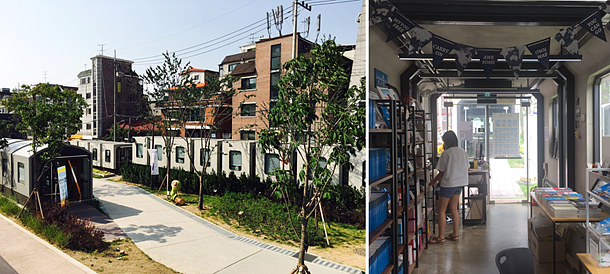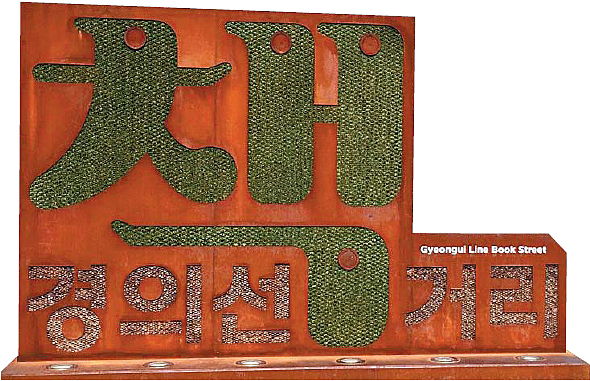Converted railroad offers literary oasis : Train cars on the Gyeongui Line Book Street are home to thematic bookstores

Left: View of the Gyeongui Line Book Street in Mapo District, western Seoul, where bookstores line a converted railway park. Right: Inside one of the train-like buildings that specialize in travel books. [GYEONGUI LINE BOOK STREET, LEE SUN-MIN]
The tracks of the old railroad have been preserved and are still visible as visitors walk up and down the Book Street. The area is more of a park, and the trees and shrubbery mimic the vegetation that might grow in an abandoned railyard. Along the main street are nine boxy buildings meant to resemble a train, and six of these “train cars” house bookstores. The other three are used as meeting or exhibition spaces.
The Book Street opened in October, and each store is filled with books from one local publisher specializing in different themes such as travel and literature. Here, visitors can go in, read books and maybe buy one or two to take home. The train car with children’s books from Bori Publishing is especially popular on the weekends.

Left: A wall at the Gyeongui Line Book Street recreated to look like a train station where many events are held. Right: Some of the children’s books available on the Book Street. [GYEONGUI LINE BOOK STREET, LEE SUN-MIN]
The travel-themed train car is also popular as more people are planning trips for the summer. The publisher there has set up a wall where visitors can write down the cities and countries they want to go to, and a lucky handful will get a free travel guide for the travel destination of their dreams.
One train car specializes in e-books, and another on art is in the process of moving in a new publisher.
“Mapo District is where the most publishing companies are registered,” said Yoo Kyung-sik, a public relations manager for the Book Street.

A sign indicating the start of the Gyeongui Line Book Street.
Fitting the street’s legacy as a railroad, one wall contains the facade of an old-school train station. There is even a bench where passersby can sit and take photos. Many of the outdoor events with bigger crowds happen here.
The paths and trails of the park offer ideal places for biking and walking, making the Gyeongui Line Book Street an appealing locale not just for bookworms but outdoor enthusiasts as well.
BY LEE SUN-MIN [summerlee@joongang.co.kr]
To get to the Gyeongui Line Book Street, go to Hongik University station, line No. 2 or Gyeongui-Jungang Line, exit 6. The bookstores are open from 11 a.m. to 8 p.m. Tuesdays to Sundays. They are closed on Mondays. Call (02) 324-6200 or go to gbookst.or.kr.










with the Korea JoongAng Daily
To write comments, please log in to one of the accounts.
Standards Board Policy (0/250자)